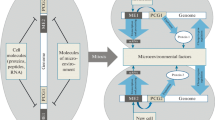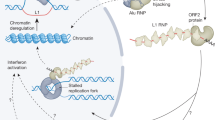Abstract
In addition to transcription factors, epigenetic factors, which control the release of genetic information in each cell division, play an important role in the regulation of gene expression in the ontogenesis of multicellular eukaryotes. Many binding sites for transcription factors were derived from transposon sequences. Mobile elements are also important sources of noncoding RNA. Thus, transposons have an indirect effect on gene expression and genome methylation. In evolution transposons serve as important sources for the origin of new protein and proteins domains. A number of studies have determined that long noncoding RNAs and microRNAs can be translated into functional peptides. At the same time, transposons are expressed in embryogenesis and remain active in the stem cells of adult humans, which is consistent with the transcription of noncoding RNAs. The study of these processes may be the key to the determination of aging mechanisms due to the role of mobile elements as sources of noncoding RNAs translated into functional peptides.



Similar content being viewed by others
REFERENCES
Anisimov, V.N., Khavinson, V.Kh., Morozov, V.G., and Dil’man, V.M., Lowering of the threshold of susceptibility of hypothalamo-pituitary system to estrogen feedback effect under the influence of pineal extract in old female rats, Dokl. Akad. Nauk SSSR, 1973, vol. 213, no. 2, pp. 483–485.
Zaitseva, Yu.V., Popova, A.A., and Khmel, I.A., Quorum sensing regulation in bacteria of the family Enterobacteriaceae, Russ. J. Genet., 2014, vol. 50, no. 4, pp. 323–340.
Kozak, M.V. and Teplyi, D.L., Age- and sex-related differences of hypothalamic neuroendocrine center response to α-tocopherol acetate and Thymalin preparation, Adv. Gerontol., 2011, vol. 1, no. 1, pp. 76–80.
Milyutina, Yu.P., Kozina, L.S., Arutyunyan, A.V., et al., Effect of peptide preparations of the epiphysis on proliferative processes in the organotypic culture of the hypothalamus preoptic region, Usp. Gerontol., 2007, vol. 20, no. 4, pp. 61–63.
Moskalev, A.A., Starenie i geny (Aging and Genes), St. Petersburg, 2008, p. 360.
Mustafin, R.N. and Khusnutdinova, E.K., The interaction of transposons with epigenetic factors in aging, Usp. Gerontol., 2017, vol. 30, no. 4, pp. 516–529.
Mustafin, R.N. and Khusnutdinova, E.K., Noncoding parts of genomes as the basis of epigenetic heredity, Vavilovskii Zh. Genet. Sel., 2017, vol. 21, no. 6, pp. 742–749.
Khavinson, V.Kh., Peptidnaya regulyatsiya stareniya (Peptide Regulation of Aging), St. Petersburg: Nauka, 2009.
Khavinson, V.Kh., Solovyov, A.Yu., and Shataeva, L.K., Molecular mechanism of interaction between oligopeptides and double-stranded DNA, Bull. Exp. Biol. Med., 2006, vol. 141, no. 4, pp. 457–461.
Anderson, D.M., Anderson, K.M., Cang, C.L., et al., A micro peptide encoded by a putative long noncoding RNA regulates muscle performance, Cell, 2015, vol. 160, pp. 595–606.
Belancio, V.P., Roy-Engel, A.M., and Deininger, P.L., All y’all need to know ‘bout retroelements in cancer, Semin. Cancer Biol., 2010, vol. 20, pp. 200–210.
Borchert, G.M., Holton, N.W., Williams, J.D., et al., Comprehensive analysis of microRNA genomic loci identifies pervasive repetitive-element origins, Mobile Genet. Elem., 2011, vol. 1, pp. 8–17.
Campillos, M., Doerks, T., Shah, P.K., and Bork, P., Computational characterization of multiple Gag-like human protein, Trends Genet., 2006, vol. 22, no. 11, pp. 585–589.
Clarke, I.J., Hypothalamus as an endocrine organ, Compr. Physiol., 2015, vol. 5, no. 1, pp. 217–253.
Coon, S.L., Munson, P.J., Cherukuri, P.F., et al., Circadian changes in long noncoding RNAs in the pineal gland, Proc. Natl. Acad. Sci. U.S.A., 2012, vol. 109, pp. 13319–13324.
Couzigou, J.M., Lauressergues, D., Becard, G., and Comier, J.P., miRNA-encoded peptides (miPEPs): a new tool to analyze the role of miRNAs in plant biology, RNA Biol., 2015, vol. 12, pp. 1178–1180.
Couzigou, J.M., Andre, O., Cuillotin, B., et al., Use of microRNA-encoded peptide miPEP172c to stimulate nodulation in soybean, New Phytol., 2016, vol. 211, no. 2, pp. 379–381.
Deng, B., Cheng, X., Li, H., et al., Microarray expression profiling in the denervated hippocampus identified long noncoding RNAs functionally involved in neurogenesis, BMC Mol. Biol., 2017, vol. 18, no. 1, p. 15. doi 10.1186/s12867-017-0091-2
Djebali, S., Davis, C.A., Merkel, A., et al., Landscape of tran scription in human cells, Nature, 2012, vol. 489, no. 7414, pp. 101–108.
Dupressoir, A., Lavialle, C., and Heidmann, T., From ancestral infectious retroviruses to bona fide cellular genes: role of the captured syncytins in placentation, Placenta, 2012, vol. 33, no. 9, pp. 663–671.
Feschotte, C., Transposable elements and the evolution of regulatory networks, Nat. Rev. Genet., 2008, vol. 9, no. 5, pp. 397–405.
Fitzgerald, K.A. and Caffrey, D.R., Long noncoding RNAs in innate and adaptive immunity, Curr. Opin. Immunol., 2014, vol. 26, pp. 140–146.
Gim, J., Ha, H., Ahn, K., et al., Genome-wide identification and classification of microRNAs derived from repetitive elements, Genomic Inf., 2014, vol. 12, pp. 261–267.
Guillemin, R., Hypothalamic hormones a.k.a. hypothalamic releasing factors, J. Endocrinol., 2005, vol. 184, no. 1, pp. 11–28.
Hu, G., Dong, B., Zhang, J., et al., The long noncoding RNA HOTAIR activates the Hippo pathway by directly binding to SAV1 in renal cell carcinoma, Oncotarget, 2017, vol. 8, no. 35, pp. 58654–58667.
Huang, C.-J., Lin, W.-Y., Chang, C.-M., and Choo, K.-B., Transcription of the rat testis-specific Rtdpoz-T1 and -T2 retrogenes during embryo development: co-transcription and frequent exonisation of transposable element sequences, BMC Mol. Biol., 2009, vol. 10, pp. 74–88.
Johnson, R. and Guigo, R., The RIDL hypothesis: transposable elements as functional domains of long noncoding RNAs, RNA, 2014, vol. 20, no. 7, pp. 959–976.
Jacques, P.E., Jeyakani, J., and Bourgue, G., The majority of primate-specific regulatory sequences are derived from transposable elements, PLoS Genet., 2013, vol. 9, no. 5, p. e1003504.
Kapusta, A. and Feschotte, C., Volatile evolution of long noncoding RNA repertoires: mechanisms and biological implications, Trends Genet., 2014, vol. 30, no. 10, pp. 439–452.
Kirkwood, T.B., DNA, mutations, and aging, Mutat. Res., 1989, vol. 219, no. 1, pp. 1–7.
Kurnosov, A.A., Ustyugova, S.V., Nazarov, V., et al., The evidence for increased L1 activity in the site of human adult brain neurogenesis, PLoS One, 2015, vol. 10, no. 2, p. e0117854.
Lauressergues, D., Couzigou, J.M., Clemente, H.S., et al., Primary transcripts of microRNAs encode regulatory peptides, Nature, 2015, vol. 520, no. 7545, pp. 90–93.
Li, Y., Li, C., Xia, J., and Jin, Y., Domestication of transposable elements into microRNA genes in plants, PLoS One, 2011, vol. 6, p. e19212.
Li, N., Xie, C., Lu, N. Crosstalk between Hippo signaling and miRNAs in tumour progression, FEBS J., 2017, vol. 284, no. 7, pp. 1045–1055.
Lin, R., Ding, L., Casola, C., et al., Transposase-derived trans cription factors regulate light signaling in Arabidopsis, Science, 2007, vol. 318, pp. 1302–1305.
Lorenzetti, A.P., de Antonio, A.P.G.Y.A., Paschoal, A.R., and Domingues, D.S., PlanTE-MIR DB: a database for transposable element-related microRNAs in plant genomes, Funct. Integr. Genomics, 2016, vol. 16, pp. 235–242.
Lowe, C.B. and Haussler, D., 29 mammalian genomes reveal novel exaptations of mobile elements for likely regulatory functions in the human genome, PLoS One, 2012, vol. 7, no. 8, p. e43128.
Lu, X., Sachs, F., Ramsay, L., et al., The retrovirus HERVH is a long noncoding RNA required for human embryonic stem cell identity, Nat. Struct. Mol. Biol., 2014, vol. 21, no. 4, pp. 423–425.
Lv, S., Pan, L., and Wang, G., Commentary: primary transcripts of microRNAs encode regulatory peptides, Front. Plant Sci., 2016, vol. 7, p. 1436.
Meister, B., Herzer, S., and Silahtaroglu, A., MicroRNAs in the hypothalamus, Neuroendocrinology, 2013, vol. 98, no. 4, pp. 243–253.
Miousse, I.R., Chalbot, M.G., Lumen, A., et al., Transposable elements in response to environmental stressors, Mutat. Res., Rev. Mutat. Res., 2015, vol. 765, pp. 19–39.
Nelson, B.R., Makarewich, C.A., Anderson, D.M., et al., A peptide encoded by a transcript annotated as long noncoding RNA enhances SERCA activity in muscle, Science, 2016, vol. 351, no. 6270, pp. 271–275.
Ruiz-Orera, J., Messeguer, X., Subirana, J.A., and Alba, M.M., Long non-coding RNAs as a source of new peptides, eLife, 2014, vol. 3, p. e03523. doi 10.7554/eLife.03523
Saghatelian, A. and Couso, J.P., Discovery and characterization of smORF-encoded bioactive polypeptides, Nat. Chem. Biol., 2015, vol. 11, no. 12, pp. 909–916.
Sturm, A., Ivics, Z., and Vellai, T., The mechanism of ageing: primary role of transposable elements in genome disintegration, Cell. Mol. Life Sci., 2015, vol. 72, no. 10, pp. 1839–1847.
Tajnik, M., Vigilante, A., Braun, S., et al., Inergenic Alu exonisation facilitates the evolution of tissue-specific transcript ends, Nucleic Acids Res., 2015, vol. 43, no. 21, pp. 10492–10505.
Taouis, M., MicroRNAs in the hypothalamus, Best Pract. Res., Clin. Endocrinol. Metab., 2016, vol. 30, no. 5, pp. 641–651.
Upton, K.R., Gerhardt, D.J., Jesuadian, J.S., et al., Ubiquitous L1 mosaicism in hippocampal neurons, Cell, 2015, vol. 161, no. 2, pp. 228–239.
van Meter, M., Kashyap, M., Rezazadeh, S., et al., SIRT6 represses LINE1 retrotransposons by ribosylating KAP1 but this repression fails with stress and age, Nat. Commun., 2014, vol. 5, p. 5011.
Wang, J., Li, X., Wang, L., et al., A novel long intergenic noncoding RNA indispensable for the cleavage of mouse two-cell embryos, EMBO Rep., 2016, vol. 17, pp. 1452–1470.
Watanabe, T., Cheng, E., Zhong, M., and Lin, H., Retrotransposons and pseudogenes regulate mRNAs and lncRNAs via the piRNA pathway in the germline, Genome Res., 2015, vol. 25, no. 3, pp. 368–380.
Yang, D., Lian, T., Tu, J., et al., LncRNA mediated regulation of aging pathways in Drosophila melanogaster during dietary restriction, Aging (N.Y.), 2016, vol. 8, no. 9, pp. 2182–2203.
Zdobnov, E.M., Campillos, M., Harrington, E.D., et al., Protein coding potential of retroviruses and other transposable elements in vertebrate genomes, Nucleic Acids Res., 2005, vol. 33, no. 3, pp. 946–954.
Zhang, G., Li, J., Purkayastha, S., et al., Hypothalamic programming of systemic ageing involving IKK-β, NF-κB and GnRH, Nature, 2013, vol. 497, no. 7448, pp. 211–216.
Zhang, J., Mujahid, H., Hou, Y., et al., Plant long ncRNAs: a new frontier for gene regulatory control, Am. J. Plant. Sci., 2013, vol. 4, no. 5, art. ID 32139.
Zhang, L., Cai, Z., Wei, S., et al., MicroRNA expression profiling of the porcine developing hypothalamus and pituitary tissue, Int. J. Mol. Sci., 2013, vol. 14, no. 10, pp. 20326–20339.
Author information
Authors and Affiliations
Corresponding author
Additional information
Translated by E. Sherstyuk
Rights and permissions
About this article
Cite this article
Mustafin, R.N., Khusnutdinova, E.K. Epigenetic Hypothesis of the Role of Peptides in Aging. Adv Gerontol 8, 200–209 (2018). https://doi.org/10.1134/S2079057018030128
Published:
Issue Date:
DOI: https://doi.org/10.1134/S2079057018030128




